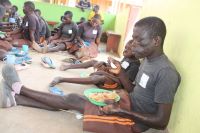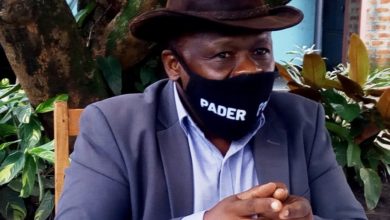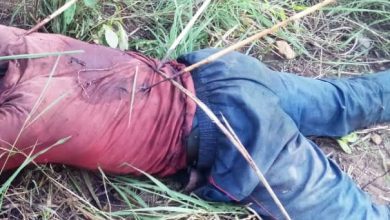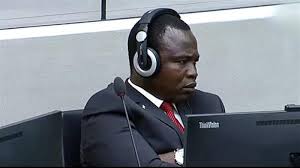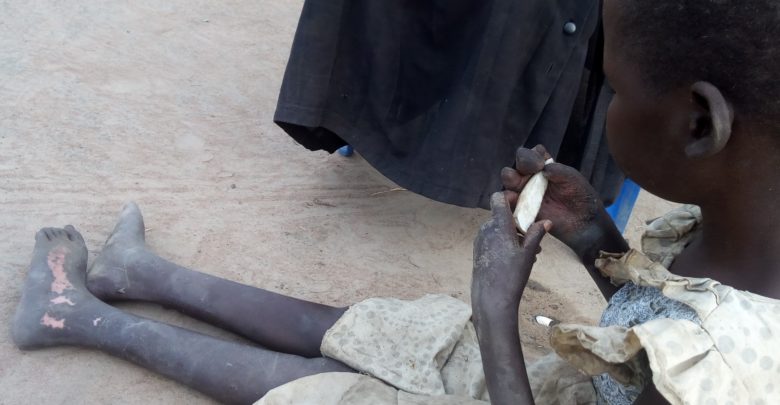
Global Politics
UGANDA: WAR LORD JOSEPH KONY’S BIRTH PLACE IS HOME TO 350 NODDING SYNDROME AFFECTED CHILDREN.
The likes of Alanyo are dying in cold blood, may one day the divine power may answer their call, or nature will do its work, the community wonders.
Alanyo2.jpg
The WHO Constitution 1946 states: “The enjoyment of the highest attainable standard of health is one of the fundamental rights of every human being without distinction of race, religion, political belief, economic or social condition” adopted almost 74 years ago.
For years, the World Health Organization (WHO) has turned blind eyes to the Nodding Syndrome affecting children in Northern Uganda, according to a mother of one of the victims. The community in the affected areas wonders if the Government of Uganda’s Health Ministry is faking ignorance to the plight of the former war affected community in Acholi Sub-Region. 10,000 Nodding Children have been thriving at the mercy of God.
At Aromo-wang-lobo, Omoro District in Northern Uganda, every household in the community is still in agony with the pain of living with Nodding Syndrome traumatic children, who end up loitering and getting drawn in water bodies or get burned while escaping from their parents.
Omoro-UGANDA: 19-year-old Fiona Alanyo, one of the affected Nodding Syndrome kids at Aromo-wang-lobo could have been married or she would have been in University like her peers but she is now like a living corpse who bears the whole mark of alienation.
Alanyo can’t barely walk or crawl. Physically, she looks stunted, both of her fingers burnt with mental retardation, and experiences frequent sneezing.
The whole homestead of Aromo-wang-lobo is dotted with Nodding children; what awaits their parents is wailing for the lost one.
The likes of Alanyo are dying in cold blood, may one day the divine power may answer their call, or nature will do its work, the community wonders.
40-year-old Lilly Akello, a mother of 5, narrates that Alanyo is her first born child within the vicinity of over 100 Nodding Syndrome affected children.
This “sitting corpse – My child” would be running around collecting some water for cooking or helping parents,” Alanyo’s Mom ponders, “but when you come to this village you can see all of them being guarded or locked up in the houses for fear that they would get out – that’s why one of the parents must remain at home, to keep an eye on them.”
Akello decries the COVID-19 pandemic worsen mental anguish to the parents of the Nodding children.
“Even if you want to use boda boda, it needs more extra two people to hold them on boda boda – local names for motorcyclists – Alanyo neither takes food nor medicine that is why she has been convulsing so frequently.”
Akello attributed that the challenge of her daughter and many other Nodding affected children to lack of drugs as result of COVID-19 pandemic and absence of the donors who were the core funding of Hope for Humanity Nodding Syndrome Center – the center is closed indefinitely.
She added that parents have to walk 10 kilometers to get drugs in Odek Health Center III, a far distance.
In the past they used to get drugs from St. Peter private Health facility in Awere trading center, Lamala parish. But it has been transferred to Odek Health Center III because Omoro Local Government has taken over supply of Nodding Syndrome drugs.
Medical reports from the Center on the statistics of the Nodding Syndrome affected children in Odek Sub-County were actually higher than Akello’s claims, according Kenneth Odokonyero, the caretaker of Hope for Humanity Nodding Center.
“We have 350 Nodding Syndrome suffering children who have been getting drugs, while 200 of them were living in the Center, and 150 were outpatients,” Odokonyero said.
Odokonyero says the community battling with Nodding Syndrome are living in denial for the cause of the nodding syndrome is not known since people went back from the former Internal Displaced People IDP camps in 2008.
According to researchers who have struggled to find a cause of the syndrome since it was first documented in Tanzania in the 1960’s.
“They thought it might have to do with the toxins, chemicals in the environment or nutritional deficiency,” Avindra Nath, M.D., clinical director of the NIH’s National Institute of Neurological Disorders and Stroke (NINDS).
So far little attention has been paid to the potential role of mycotoxins consumed in the staple foods in causing neurological disease despite known neurotoxic effects in humans. Mycotoxins are secondary metabolites produced by toxigenic fungi that infect food crops both in field and story.
54-year-old Galdino Oganya and 60-year-old Okello Tony from Lakim village in Odek Sub County both lost their children to nodding syndrome.
The late Okello’S child, Opiyo Collin, drawn in River Aswa when he had disappeared from home. To date, Okello looks bitter.
He said had tried to
Okello’s several attempts to treat his child who was fighting for his life with nodding syndrome failed after various health facilities told him there was no cure of nodding syndrome.
“I have moved to many health facilities including St Mary’s Hospital Lacor, but all the doctors after examining my child they would tell me to take my child back home and continue treating him – that is all,” Okello said.
Oganya who bore the brunt of pain in nourishing his child called Odong – before burying him – disclosed that half of the affected Nodding children died.
“We have buried more than 150 children with nodding syndrome in Odek Sub County alone,” Oganya lamented.
Five children with nodding syndrome had drowned in Omoro District on separate occasions.
According to area leaders, the children, aged between 14 and 15 years, were said to have died in January and June in 2014 in different villages in Odek Sub-county after developing sneezing at water points.
In July 2014, the organisation’s Chief Executive Officer Ms Suzanne Gazda, said the board of directors had made a ‘difficult decision’ to dissolve Hope for Humans and transition the children into the care of the Ugandan government.
Ideally, this centre should still be taking care of children, including carrying out community outreach programmes in homes of those recovering from nodding syndrome. But due to lack of funds, the 29 children still living at the centre and another 237 who were rehabilitated and reintegrated in their communities, are not receiving the care they need to prevent possible relapse.
Dr. Robert Ongom, the District Health Services Officer of Omoro district declined to comment on the fate of Nodding affected Children when contacted by the Black Star News. Attempt to get the list of the missing one from the Omoro District Health Center IV, was futile.
The Deputy Speaker August House, Jacob Oulanyah initiated UGX 150 billion to bail out the affected Nodding Syndrome who remain without government support when the donors withdrew from Northern Uganda.
Jacob Oulanyah says the COVID-19 pandemic has caused many roadblocks in the struggle to get other donors fund, otherwise although the community of Aromo-wang-lobo repeatedly calls to build for them the residences and support those nodding children. If there was no COVID-19 pandemic. Such intervention would be handled.
45-year-old Kenneth Odongkara Chairperson and his Vice Chairperson Akello – mother of Alanyo – of a Nodding syndrome founded Micro Finance group called (Adaa rii), instituted in 2019, had raised UGX 1.9 million to support the nodding syndrome.
Every week each of the 30 members of the group could contribute any amount of money, which each member would borrow any amount to support the victims, Odokonyero revealed.
“We realized that as the parents of the affected children in Aromo-wang-lobo we could raise small money to support us,” he said.
He said in 2019, the community of Aromo-wang-lobo received in kind support of UGX 200,000 from World At Play, WAP, a Kampala-based NGO, offered and banana suckers, maize seeds, beans, cow peas, mango seedlings from Comboni Samaritan.
Doglus Okello Okao said in 2019, Omoro District gave NUSAF UGX 24O million to support nodding syndrome affected children in Odek Sub County to help them in food nutrition, buy ox ploughs and oxen to help them in livelihood.
The community received only UGX 70 million of the offered amount used to buy ox-ploughs 7-oxen for Aromo-wang-lobo and 5-oxen for Lakim Anyim-lac group, Odokonyero said, adding that some of the oxen died because they were too young while others are still growing.
In 2014 the Ministry of Health sent a team of 124 medical experts to the districts Districts of Gulu, Kitgum, Pader, Lamwo among others that were affected by the Nodding Ssyndromee to assess whether it has been completely wiped out.
Health ministry had never recorded any new case of the nodding disease since 2012, according to the then Health Minister Dr Ruhakana Rugunda.
Ends

